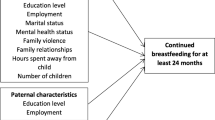Abstract
Background Sex of child has been shown to impact breastfeeding duration in India, Australia, Scandinavia, Latin America, and, within the US, in a sample in Eastern Connecticut and in a separate sample of Indian and Chinese immigrants. Objectives The objective of this study is to examine differences in breastfeeding initiation and duration by sex of child across racial/ethnic groups in the US. Methods We used the Pregnancy Risk Assessment Monitoring System 2009–2010 and logistic regression to examine whether sex of child impacts breastfeeding initiation and duration for at least 8 weeks by women’s racial/ethnic group. Results Among the 66,107 women in our sample representing 12 different race/ethnic groups, Hispanic women (n = 9049) had lower odds of breastfeeding initiation (adjusted odds ratio [AOR] = 0.81, 95% CI 0.71–0.93) and breastfeeding duration (AOR = .87, 95% CI 0.80–0.96) if they have sons compared to Hispanic women who have daughters. Sex of child did not impact the odds of breastfeeding initiation or duration among any other race/ethnic group. Conclusion We have shown that, for Hispanics in the US, sex of child may have an impact on breastfeeding, a health behavior that has a variety of positive impacts on infants throughout their lives. Boys, relative to girls, were at a disadvantage in breastfeeding initiation and duration. Future work is necessary to unpack the mechanisms behind these findings. In particular, how sex of child impacts how mothers and fathers view the nutritional needs of their children and breastfeeding more broadly.
Similar content being viewed by others
References
CDC. (2011). Rates of any and exclusive breastfeeding by socio-demographics among children born in 2011 (Percentage ± half 95% confidence interval). (n.d.). Retrieved May 24, 2016 from http://www.cdc.gov/breastfeeding/data/nis_data/rates-any-exclusive-bf-socio-dem-2011.htm.
CDC. (2016). About PRAMS—Pregnancy Risk Assessment Monitoring System—Reproductive Health. (n.d.). Retrieved May 24, 2016 from http://www.cdc.gov/prams/aboutprams.htm.
Chung, M., Raman, G., Chew, P., Magula, N., Trikalinos, T., & Lau, J. (2007). Breastfeeding and maternal and infant health outcomes in developed countries. Evidence Report Technological Assesment, 153, 1–186.
Coryllos, E., Genna, I. C. W., & Salloum, I. A. C. (2004). Section on breastfeeding. Retrieved from http://www.lunalactation.com/Ankyloglossia_AAPnewsletter.pdf.
Davis, S. N., & Greenstein, T. N. (2009). Gender ideology: Components, predictors, and consequences. Annual Review of Sociology, 87–105.
Ferris, A. M., McCabe, L. T., Allen, L. H., & Pelto, G. H. (1987). Biological and sociocultural determinants of successful lactation among women in Eastern Connecticut. Research Gate, 87(3), 316–321.
Guendelman, S., Kosa, J. L., Pearl, M., Graham, S., Goodman, J., & Kharrazi, M. (2009). Juggling work and breastfeeding: effects of maternity leave and occupational characteristics. Pediatrics, 123(1), e38–e46.
Hawkins, S. S., Griffiths, L. J., Dezateux, C., & Law, C. (2007). Maternal employment and breast-feeding initiation: findings from the Millennium Cohort Study. Paediatric and Perinatal Epidemiology, 21(3), 242–247.
Jayachandran, S., & Kuziemko, I. (2009). Why do mothers breastfeed girls less than boys? Evidence and implications for child health in India. National Bureau of Economic Research. Retrieved from http://www.nber.org/papers/w15041.
Kimbro, R. T. (2006). On-the-job moms: Work and breastfeeding initiation and duration for a sample of low-income women. Maternal and Child Health Journal, 10(1), 19–26.
Lhila, A., & Simon, K. I. (2008). Prenatal health investment decisions: Does the child’s sex matter? Demography, 45(4), 885–905.
Lundberg, S. (2005). Sons, daughters, and parental behaviour. Oxford Review of Economic Policy, 21(3), 340–356.
Mandal, B., Roe, B. E., & Fein, S. B. (2010). The differential effects of full-time and part-time work status on breastfeeding. Health Policy, 97(1), 79–86.
Michaelsen, K. F., Larsen, P. S., Thomsen, B. L., & Samuelson, G. (2008). The Copenhagen cohort study on infant nutrition and growth: Duration of breast feeding and influencing factors. Acta Paediatrica, 83(6), 565–571. 10.1111/j.1651-2227.1994.tb13082.x.
Pande, H., Unwin, C., & Håheim, L. (1997). Factors associated with the duration of breastfeeding: Analysis of the primary and secondary responders to a self-completed questionnaire. Acta Paediatrica, 86(2), 173–177. 10.1111/j.1651-2227.1997.tb08862.x.
Pérez-Escamilla, R., Ck, L., Segall, A. M., Rivera, A., Treviño-Siller, S., & Sanghvi, T. (1995). Exclusive breast feeding duration is associated with attitudinal socio-economic and biocultural determinants in three Latin American Countries. ResearchGate, 125(12), 2972–2984.
Rippeyoung, P. L., & Noonan, M. C. (2012). Is breastfeeding truly cost free? Income consequences of breastfeeding for women. American Sociological Review, 77(2), 244–267.
Roe, B., Whittington, L. A., Fein, S. B., & Teisl, M. F. (1999). Is there competition between breast-feeding and maternal employment? Demography, 36(2), 157–171.
Scott, J., Aitkin, I., Binns, C., & Aroni, R. (1999). Factors associated with the duration of breastfeeding amongst women in Perth, Australia. Acta Paediatrica, 88(4), 416–421. https://doi.org/10.1080/08035259950169800.
Winship, C., & Radbill, L. (1994). Sampling weights and regression analysis. Sociological Methods & Research, 23(2), 230–257.
World Health Organization, & UNICEF. (2003). Global strategy for infant and young child feeding. World Health Organization. Retrieved from https://books.google.com/books?hl=en&lr=&id=biABXOXrajYC&oi=fnd&pg=PR4&dq=World+Health+Organization,+%26+Unicef.+(2003).+Global+strategy+for+infant+and+young+child+feeding.&ots=1lE4e8a_RO&sig=CWpyKx2SnvmseB0nNxrtu1ZC6qk.
Funding
The authors have no financial support to report.
Author information
Authors and Affiliations
Corresponding author
Ethics declarations
Conflict of interest
The authors have no conflicts of interest to report.
Electronic supplementary material
Below is the link to the electronic supplementary material.
Rights and permissions
About this article
Cite this article
Shafer, E.F., Hawkins, S.S. The Impact of Sex of Child on Breastfeeding in the United States. Matern Child Health J 21, 2114–2121 (2017). https://doi.org/10.1007/s10995-017-2326-8
Published:
Issue Date:
DOI: https://doi.org/10.1007/s10995-017-2326-8




